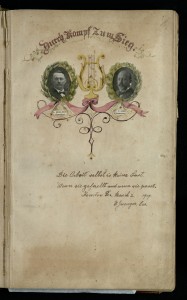
The University of Houston Special Collections is happy to announce both the recent publication of the Houston Saengerbund Records in the UH Digital Library and significant additions and revisions made to the finding aid for the related physical collection housed here in Special Collections!
The Houston Saengerbund is a German singing society that has been active in Houston for more than a century and continues to perform at public events throughout Houston and Texas to this day. It was founded in 1883 and was one of many all-male singing organizations which formed in the German communities of Texas during the last half of the 19th century. These local groups were united under Der Deutsch-Texanische Saengerbund (the German-Texan Singers’ League), a regional organization that held biennial meetings and Saengerfeste (Singing Festivals) in various Texas cities. Both the digital collection and physical materials provide insight not only into the activities, performances, membership, and administration of this group, but also into its responses to major events and social changes throughout the last century of American history.
The digital collection consists of five bound ledgers covering the years 1874-1937. In these ledgers you’ll find meeting minutes, financial statements, programs, clippings, and correspondence between the Houston Saengerbund and other German organizations. The materials span the time from the group’s inception, through its growth to over 1000 members in the years before World War I, and to the formation of the Ladies Auxiliary and the Damenchor (Women’s Chorus) in 1937.
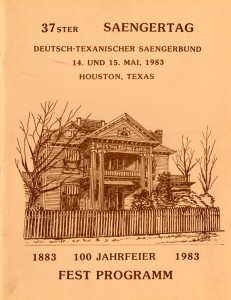
Program from the 1983 Texas Saengerfest, held in Houston and also marking the Houston Saengerbund’s centennial
The updated finding aid describes physical materials dating from 1874 to present. Here you’ll find songbooks and event materials, administrative records, legal files, financial records, and publications from all points in the group’s history. Of particular interest is the effect of anti-German sentiment that developed during the World Wars. With the onset of World War II, the Saengerbund members changed the name of the group to “The Houston Singing Society,” quit their primary activity of singing German songs, and began keeping minutes in English due to their concern about arousing anti-German sentiment. It wasn’t until after the war ended that the club members restored both their singing and their name.
The events mentioned above are just a couple of the points of interest to be found in the rich and storied history of The Houston Saengerbund. Check out the digital collection or visit us here in Special Collections to find out more!
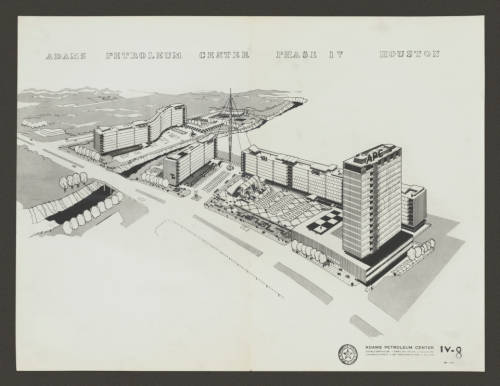
Donald Barthelme, Adams Petroleum Center (c. 1955), aerial view of the proposed complex on Fannin at Brays Bayou. (Donald Barthelme Architectural Papers and Photographs)
The UH Digital Library recently announced its newest addition—the Donald Barthelme Sr. Architectural Papers and Photographs. The Digital Library makes accessible online important holdings of the University of Houston libraries and archives. These new items illustrate the work of noted architect Donald Barthelme through pencil sketches, photographs, and the detailed working drawings used to construct his buildings. They are only a small part of the total found in the Donald Barthelme Sr. Architectural Papers, but they illustrate his most important projects.
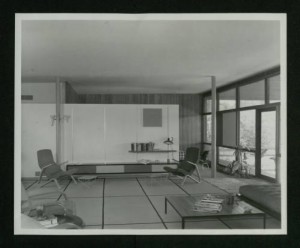
Barthelme Residence (c. 1952), living room looking east with parents’ bedroom in the background. (Donald Barthelme Sr. Architectural Papers and Photographs)
The earliest is Barthelme’s own residence (1939), a small flat-roof modernist house on Wynden Drive. The open plan created the illusion of a larger space within. A grid of Japanese tatami mats covering the floor met a similar grid of windows facing the patio. He filled the living room with iconic modernist furniture by Alvar Aalto, Charles Eames, and Eero Saarinen. In an unusual feature, the parents’ bedroom was open to the living room; a folding screen provided privacy from the children.
St. Rose of Lima Church and School won an award of merit from the American Institute of Architects in 1948 for its simple and austere brick forms. But Barthelme’s most important building was the award-winning West Columbia Elementary School,
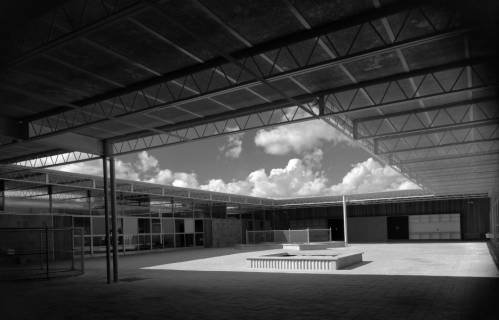
Donald Barthelme, West Columbia Elementary School (1951), north court. (Donald Barthelme Architectural Papers and Photographs)
completed in 1951. Its innovative design departed from the traditional practice of placing classrooms along both sides of a long corridor. Instead, he arranged the building around two large courtyards; classrooms opened to the courts through floor-to-ceiling glass walls. The picture of a teacher and her students captures the cheerful atmosphere of Barthelme’s light-filled classrooms.
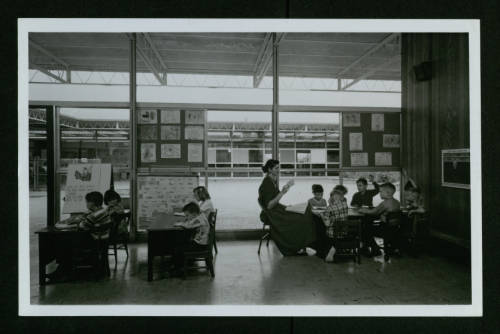
West Columbia Elementary School (1951), view of classroom with teacher and students. (Donald Barthelme Architectural Papers and Photographs)
In the mid-1950s, the Adams Petroleum Company hired Barthelme to design its new office building on Fannin Street. The company hoped to develop the large site as an office park, with the APC building to be followed by other office buildings. Barthelme spent hundreds of hours planning the large complex before Adams abandoned the scheme. The Digital Library contains a selection of rarely seen studies for this ambitious unbuilt project.
Through the UH Digital Library the public now has easy access to these images, some of which have never been published. As usual, the Donald Barthelme Sr. Architectural Papers are available to researchers at the UH Libraries’ Special Collections department.
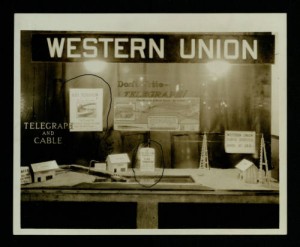
Naming campaign, Western Union storefront (1927) / from the USS Houston (CA-30) Photographs / (sign in window reads, “if you want a new cruiser named ‘U.S.S. Houston’ telegraph your congressman or the Secretary of the Navy”)
The recent publication of the USS Houston (CA-30) Photographs, adding to the growing Military History Collections at our Digital Library, marks another major milestone and means even more research potential for remote scholars unable to visit our rich USS Houston physical archives and materials.
Pulled from the photographs of the Cruiser Houston Collection, this new digital collection highlights the history of the heavy cruiser and her crew–the survivors, prisoners of war, and those who gave all. The flagship of the Asiatic Fleet during World War II, the Houston fought in the Battle of the Java Sea and to her bitter end at the Battle of Sunda Strait, sinking just after midnight as February turned into March, 1942. Highlights in the collection date back to the naming campaign that gave her our city’s name, include documentation of President Franklin D. Roosevelt’s affinity for the Houston as his vessel of choice for sea voyages and deep sea diversions during his presidency, show haunting scenes from those infamous POW camps, and testify to the resolve of 1,000 “Houston Volunteers” who answered the call sent out by the sinking of the Houston.
![Evacuation of POWs, Rat Buri, Thailand ([1945])](http://weblogs.lib.uh.edu/speccol/files/2014/09/evacuation_of_pows_rat_buri_thailand_1945-300x215.jpg)
Evacuation of POWs, Rat Buri, Thailand [1945] / from the USS Houston (CA-30) Photographs
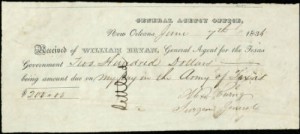
$200 pay certificate for Alexander Wray Ewing (June 7, 1836), for “my pay in the Army of Texas.” Ewing served as surgeon general of the Texas army and, two months prior, had treated Sam Houston at the battle of San Jacinto. — (available for high-resolution download through our Digital Library or for further study via our Early Texas Documents Collection)
The digitization of the Early Texas Documents Collection which has recently been published has been a monumental task several years in the making. With nearly 1,300 items, the documents trace not only the activities of prominent Texans and founders, such as Sam Houston and Stephen F. Austin, but give researchers a glimpse into what life was like for Texans in the early 19th through transactions involving land, finances, legal matters, and in some cases chattel and slaves. In addition, military documents chronicle the Battle of San Jacinto between General Sam Houston and Santa Anna’s forces. There are also military scrips that document the pay soldiers received for their time of service within the Texas Army and Navy.
Genealogists may also find the documents of interest as the subjects of their research may have written letters, or their names may appear on financial or legal documents contained within the collection. The collection also contains early examples of currency utilized during the Republic era. Selections of these currencies have been featured in the exhibit On the Run: Currency, Credit and Capitals of the Republic of Texas this past June at the Texas Capital Visitors Center in Austin. In short, the collection contains something for everyone.
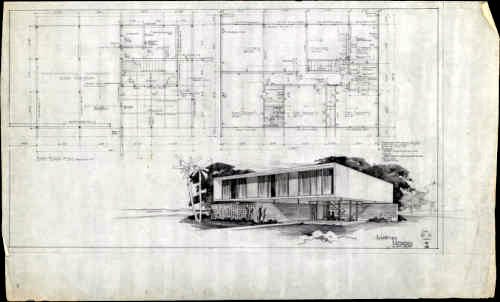
Lucian Hood, House on Sandy Cove Drive, Houston,1961, Digital Collection
The Lucian T. Hood Architectural Papers have joined the UH Library’s Digital Library collections. Lucian Hood (1916 – 2001) was an important Houston architect who made his reputation as a house designer for the rich and famous. During the 1970s and 1980s he had one of the largest and best-known residential design practices in the city.
Hood earned his architecture degree from the University of Houston in 1952. He studied under such prominent architects as Donald Barthelme, Sr. and Howard Barnstone. Among his classmates were Burdette Keeland, Jr. (UH 1950) and Kenneth E. Bentsen (UH 1952), both of whom went on to distinguished architectural careers. The Barthelme, Keeland, and Bentsen papers are among the important Architecture and Planning collections held by the library’s Special Collections Department.
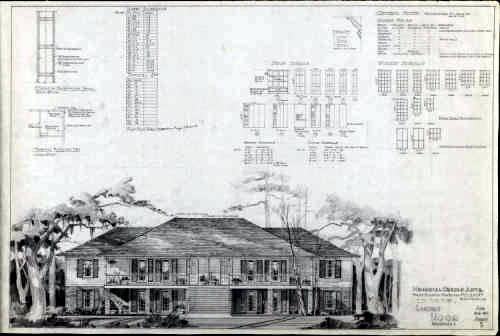
Lucian Hood, Memorial Creole Apartments, Houston, 1966, Digital Collection
Early in his career Hood designed both commercial and residential buildings but by the late 1960s had switched to residential architecture exclusively. His work is well represented in the affluent River Oaks, Memorial, and Tanglewood neighborhoods of Houston. His houses were usually traditional in style and were notable for his attention to the many traditional details that brought the designs to life.
The Lucian T. Hood Architectural Papers are the largest of Special Collections’ Architecture and Planning collections. Covering the four decades from 1961 to 2001, the collection encompasses approximately 900 projects. Unfortunately, most of Hood’s early work from the 1950s was lost before the library acquired the materials.
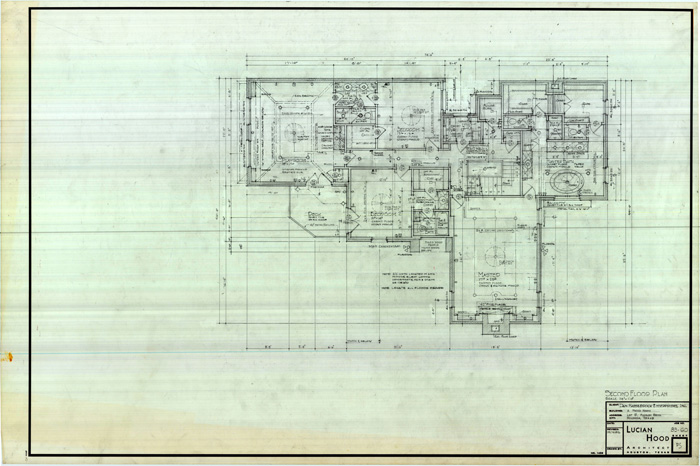
Lucian Hood, second floor plan of residence, Houston, 1983, Lucian T. Hood Architectural Collection
Special Collections often receives requests for copies of the Hood drawings—usually from patrons who own a Lucian Hood-designed house and want copies of the architect’s original plans. The department welcomes the chance to make the Hood drawings accessible online, but because of the enormous size of the collection, only a small part has been digitized. The Digital Library has the projects from the 1960s, but more may be added in the future. Until then, patrons seeking copies from the Lucian T. Hood Architectural Papers should contact the Special Collections Department for assistance.
